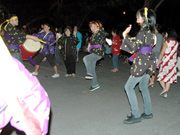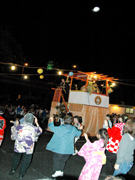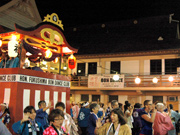Let’s look at the linguistic module of the Bon Dance in Hawaii in the end of “the aspect of the art”.
At first, let’s look at the “lyrics” of the Odori-kyoku (concretely, the song of Bon Dance). Each Odori-kyoku has the “lyrics”, but the way of existence differs according to the type of Odori-kyoku.
■ Traditional type Odori-kyoku – the lyrics of the Bon Dance song
The lyrics of Bon Dance widely differ depending on the type of Odori-kyoku in “Traditional type” and “Modern type”.
In the “Modern type Odori-kyoku”, in most cases the lyrics become a fixed and peculiar one because basically the lyrics are created together with the composition of the music, and they are mediated by the recording reproduction type media such as records.
The lyrics of the “Folk song dance type Odori-kyoku” and “Modern dance song type Odori-kyoku” which are especially large in numbers, are almost the same between Japan and Hawaii, so we won’t take them up in here.
On the hand, “Traditional type Odori-kyoku” has a strong image that “it is inheriting the old lyrics continuously”, but in reality, it has a more flexible and complex style of lyrics than the Modern dance song type Odori-kyoku.
“Kouta” and “Kudoki”
In the case of Traditional type Odori kyoku (Mainland type), the singing form is divided into the so-called Kouta Form and Kudoki Form which are “the 2 largest singing forms of the Modern times Bon Dance Songs”
|
||||||||
| In the case of Odori-kyoku in Hawaii, “Fukushima Ondo” which originates in Eastern Japan will be Kouta Form, and “Iwakuni Ondo” which originates in Western Japan will be Kudoki Form. The 2 largest song | ||||||||
The lyrics of Fukushima Ondo (Kouta Form)
(How to Sing)
Haa You Fue ya Taikoni Tsui Sasowarete You
Hahaa Watasha Ikimasu Koresa Bon Odori You
Ikoyo Meshizaka Ide Yuno Machini
Atsui Nasakeno Yuno Kaori
Waikiki Hamabeni Yosetewa Kaesu
Onna Nami Otoko Namino Kuruizaki
Susuri Nakuyona Gitaa no Toone
Dokode Odoruka Fura Musume
Amai Kaorino Jinja no Reio
Kakete Odoroyo Bon Odori
Fukushima Ondode Nigiyakani Odore
Jiisamamo Baasamamo Mina Odore
Fukushima Meibutsu Kazu Kazu Aredo
Kakini Orimono Miharu Goma
Lyrics of Iwakuni Ondo (Kudoki Form)
1. Toki kore Shouwa no 16 nen Gokugetsu Nanokano Asa Madaki
Seiki no Arashi Kumowo Yobi Yumewo Yaburishi Rakuen wa
Tsuini Hiwohaku Shinjuwan Aseto Namidade 50nen
Waga Douhouga Kizukitaru Sono Ishizuemo Guratsukite
Yasuki Kokorowa Aranamino Kuroshio Sawagu Taiheiyou
5. Teni Tewo Torite Itsunohika Tomoni Hawaini Kaeranto
Chikaishi Tomowa Imawanaku Banri Ikyouno Ikusanga
Nisei Onogoga Nagashitaru Chishiowa Tootoku Awasuteni
Otokono Namidawa Ametonaru
7. Tokiwa Shouwano 19nen 10gatsu Hatsukano Yomo Fukete
Tokorowa Aruzasu Waarenno Tekino Houino Sononakani
Moutotsugekiwo Kankoushi Dotouno Gotoku Tsukiireba
Kudakete Nigeru Tekino Jin Nisei Danshiga Sakebitaru
Banzai Kooruno Nawa Nokoru
9. Hawaiwo Idete Ikutoshino Doroni Mamirete Atarashiki
Sekaiheiwani Tsukushitaru Hawaiga Hokoru Hyakudaitai
Yonhyaku-Yonjuuni Butaino Isaowo Tataete Kyounohi
Tooku Ikokuno Sensenni Gokokuno Onito Kashimaseshi
Yuushino Mitamani Kokoroyori Kanshano Makotowo Sasagetsutsu
Bonno Kuyouni Taku Kouwa Amanogawanimo Todokuran
Amanogawa nimo Todokuran
The Lyrics of Eisah Series of Odori-kyoku
Nachijinnu gusuku Yonsa Miyarabinu churasa
Miyarabinu churasa Yonsa Miware chura churasa
Nachijinnu niseeta Yonsa Utagui guwanu churasa
Niseeguwa taanu utani Yonsa Udoutei ashi ashiba
Shichiguwachini nariba Yonsa Wakamunnu surutei
Teeku sanshinni Yonsa Eisah ashi ashiba
Shichiguwachinu eisah Yonsa Wakamunnu ashibi
Danjuhchi surutei Yonsa Teiutei ashi ashiba
Fuenu kaji fukiba Yonsa Wachimu wasakamichi
Umiyamani nijitei Yonsa Ashibu teida teidatei
(Hayashi)
Sa hiyaruga hei sasa hiyaruga hei

Eisah Type Odori-kyoku is a Te-Odori (Hand Dance), fun to dance.
(August 8, 2008 Pearl City, Oahu Island)
The Future of Bon Dance Songs
It seems that Japanese literacy of the Japanese descents lowered rapidly after the third generation Japanese Hawaiians.
The lyrics of the Traditional Type Bon Dance Songs are hard to understand even for the Japanese people of today, so it could be imagined that it is quite difficult for the Japanese Hawaiian who live in the English-speaking environment. This means that most dancers besides the elderly people are dancing without understanding the meaning of the lyrics, although it is a much awaited live music (The situation is the same in Traditional Type Bon Dances in Japan).
It seems that the securement of the “Ondo Tori” (singers) is in a difficult situation. As a result, the lore of the culture of Traditional Type Odori-kyoku relies a lot to the effort of “The Bon Dance Club”.
■Hayashi Kotoba (Musical Phrase)
In the linguistic side of the aspect of the art of Bon Dance, there is “Hayashi Kotoba (Musical Phrase)” besides the lyrics.
Compared to “Information from the lyrics” which has many opportunities to be put into letters and recorded, there are few occations that Hayashi Kotoba is recorded and studied in a systematic manner, and there are a lot of cases that researchers “let it pass through their ears”. However, the “Hayashi Kotoba” which is handed down through the “scene” of the dance is a very interesting research object as a typical oral lore.
We have to pick up “Betcho” of Fukushima Ondo among the Hayashi Kotoba of Traditional type of Odori-kyoku in Hawaii . We guess that many of you know that this is a dialect that means the female genitals in the Tohoku region including Fukushima prefecture. The fact that these Hayashi Kotoba remained in Hawaii brings interesting issues in various meanings.
Hayashi Kotoba as a “Culture of Love”
First of all, Bon Dance used to be a meeting place for men and women, and there was a time when its lyrics and Hayashi Kotoba were quite dirty (comically erotic) love song.
Afterwards, this kind of lyrics and Hayashi Kotoba mostly disappeared from the scene of Bon Dance in Japan through the clampdown to Bon Dance in the Meiji Era and the modernization after the WW2. These culture were transplanted by the Japanese immigrants in Hawaii, and it happened to be handed down in this place in the original form.
Hayashi Kotoba shows the folksy recognition
Secondly, both “Fukushima Ondo” and “Niigata Ondo” (it was quite similar to Fukushima Ondo) were called “Betcho”
This word lacks class, but it being so, the amiable Hayashi Kotoba became “the song title” of Odori-kyoku. This is a valuable example that shows a part of folksy recognition which how the Japanese in the Meiji Era and the Japanese immigrants perceived the Bon Dance.
Hayashi Kotoba as a key to the propagation route
Third, if we look at the distribution of dialects in Japan’s mainland, the word “Betcho” is distributed from the northern part of Fukushima prefecture to the southern part of Miyagi Prefecture. This place neatly overlaps with the areas like Souma City where “Souma Bon Dance” , which is believed to be the origin of Fukushima Ondo, is flourishing, and Date County where they sent many immigrants to Hawaii. Moreover, it seems that the dialect “Betcho”also exists in Niigata Prefecture, as we thought.
Further, people say that the excellent piece of music, “Hokkai Bon-uta” has its origin in the Bon Dance that the immigrants from Niigata Prefecture and Fukushima Prefecture to Hokkaido brought in. It is known that the Hokkai Bon-uta was also called “Betcho Bushi” or “Betcho Odori” in the past.
From the stories written above, the Hayashi Kotoba “Betcho” itself is a very important clue, in case we trace the origin or propagation path of the Odori-kyoku, that is difficult to prove
Rich Hayashi Kotoba of Hawaii
What was impressive in the Fukushima Ondo of Hilo Higashi Hongwanji in the Hawaii Island where we visited is that the dancers dance while cheerfully screaming out “Betcho, Betcho”. However, in fact, we found out even more. We could confirm that a variety of Hayashi Kotoba exists in the circle of Fukushima Ondo
①Betcho, betcho!
②Yahtosa, yahtosa!
③Yakitori, yakitori!
④Sake, sake!
⑤Pikachuh, pikachuh!
We could hear a lot of Hayashi Kotoba in the circle of dance that make us laugh out loud. There are ones that are clearly new, and in the other hand, there are others that seems to be somewhat old. In what circumstances, and who took these Hayashi Kotoba into Hawaii ? However, there might not be much meaning in searching out for a complete explanation.
The folkways of Hayashi Kotoba in Hawaii is still continuing to change as “a live folkways”.
<
1.”Sketches of Japanese American’s Life in Hawaii” written by Ueta Kisaburo, 1970 太平洋学会 誌第91号, 2002
2. ”ハワイ日系 人のボン・ダンスの変遷” written by Yukari Nakahara (included in “民俗音楽の 課題と方法” written and edited by Nobuo Mizuno and published by 世界思想社, 2002)
3.Van Zile,Judy. The Japanese Bon Dance in Hawaii.Honolulu:Press Pacifica 1982
4.”ハワイの沖縄系”盆踊り”沖縄文化第36巻第1号 written by Naoko Terauchi, 2000
- 1.The distribution of Bon Dance in the overseas.
- 2.Bon Dance of Hawaii – The distribution and characteristics
- 3.The parent body and the participants of Bon Dance
- 4.The schedule of Bon Dance
- 5.The location of Bon Dance
- 6. ”Dance Tunes” and their types
- 7.The composition and fashion of Bon Dance
- 8.The composition of “Odori-kyoku”-Hondo type and Okinawan type
- 10. Bon Dancing in Hawaii : History
- 11.Talking about Bon Dance in Hawaii : Professor Judy Van Zile from The University of Hawaii


